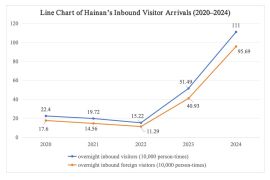"The arrivals of foreign tourists showed an upward trend from year to year. Foreign exchange contributed by the tourism sector also increased. It is higher than the national economic growth," Tourism and Creative Economic Minister Mari Elka Pangestu said recently.
In 2013, a total of 8.8 million of foreign tourists visited Indonesia, up 9.2 percent from that in the previous year. It received foreign exchange amounted to US$10.05 billion, an increase by 10.23 percent from that in 2012.
There were also 248 million domestic tourists spending Rp154.7 trillion, or double than those spent by foreign tourists last year.
"In 2013, the tourism sector contributed Rp347.35 trillion to the Gross Domestic Product (GDP), or around 3.8 percent of the countrys total GDP," Minister Pangestu said.
The tourism sector provided jobs for 10.8 million people, or 8.89 percent of the total national manpower.
The countrys optimism is more flourishing as the World Economic Forums Global Travel and Tourism Competitiveness Report 2013 showed that Indonesia is ranked 70th, or up four places since the 2011 edition.
"Indonesia is ranked 70th, or up four places from 74th in 2011," the tourism minister said in a talk show recently.
According to the Travel and Tourism Competitiveness Index 2013, Indonesia is ranked 12th in the Asia-Pacific region, right behind India.
In terms of strengths, Indonesia places sixth for its excellent natural resources, with several World Heritage natural sites and the richness of its fauna as measured by the known species in the country.
Indonesia also has rich cultural resources (ranked 38th), with 10 World Heritage cultural sites, a number of international fairs and exhibitions held in the country, and strong creative industries.
Further, the country is ranked ninth overall on price competitiveness in the T&T industry because of its competitive hotel prices (ranked 21st), low ticket taxes and airport charges, and favorable fuel prices.
"Indonesia is better in terms of natural resources, placing the country in the sixth rank, and in the price for value in the ninth rank," Pangestu said quoting the report.
Despite the improvement of its rank, Indonesia, however, is still left behind from its neighboring countries such as Singapore which is ranked 10th, Malaysia 34th, and Thailand 43rd because their infrastructure is better than that of Indonesia.
In addition, it is ranked 19th for its national prioritization of Travel & Tourism. However, these strengths are held back by underdeveloped infrastructure in the country, especially ground transport (87th), tourism infrastructure (113th), and ICT infrastructure (87th); together these represent significant investment opportunities in the country.
The Travel & Tourism Competitiveness Index covers 140 countries and uses a combination of data from publicly available sources, international travel and tourism institutions and experts.
Switzerland, Germany and Austria lead the world in terms of their travel and tourism industry competitiveness with Spain, the United Kingdom, the United States, France, Canada, Sweden and Singapore completing the top 10, according to the fifth Travel & Tourism Competitiveness Report released in March 2013.
"The travel and tourism industry has weathered the global downturn and is now playing an important role in helping tackle serious global challenges, including youth unemployment, economic development and environmental sustainability. The challenge for the industry and its stakeholders today is to maintain this powerful
contribution to economic growth and employment, while continuing to proactively pursue the shared goals of facilitating global travel and tourism and protecting host cultures, identities and environments," said Thea Chiesa, the Director and Head of Aviation, Travel & Tourism Industries of the World Economic Forum.
For 2014, the Indonesian government has lowered its target of foreign tourist arrivals from 10 million to 9.2 million, despite the countrys optimism.
"Were optimistic that 2014 is going to be a good year for the [tourism and creative] sector as we will continue our programs and strengthen collaboration with our partners such as China, Japan, Taiwan and Korea," Minister Pangestu said.
The Indonesian Central Bureau of Statistics (BPS) recently announced that the number of tourist arrivals to Indonesia in 2013 hit record high at 8.8 million for the entire year, exceeding the 8.6 million foreign arrivals target set earlier by the Ministry of Tourism and Creative Economy.
Last year, the number of foreign tourist arrivals at the Lombok International Airport significantly increased by 204 percent.
The record number of tourist arrivals, however, remained in Bali at a total 3,27 million, exceeding the Tourism Offices target of 2.8 million.
Bali reported an 11.16 percent increase in tourist arrivals last year compared to 2.94 million in 2012, Head of the Bali Central Statistics Board Panusunan Siregar recently.
"Most travelers arriving at the Ngurah Rai International Airport took flights directly from their respective countries. Only 36,709 people came to Bali via the sea route," he said.
Australians made up the majority of tourists to Bali, with 826,386 visitors and contributing 25.21 percent of tourist arrivals to the island last year.
This is followed by China with 387,533 visitors, Japan (208,115) and 199,223 and 138,397 arrivals from Malaysia and Singapore respectively. Other tourists came from South Korea (134,452), Taiwan (127,443), France (125,113), Britain (122,406) and 108,863 from the United States. ***2***
(T.F001/A/F001/B003) 24-02-2014 23:18:41
Editor: Fardah Assegaf
Copyright © ANTARA 2014











